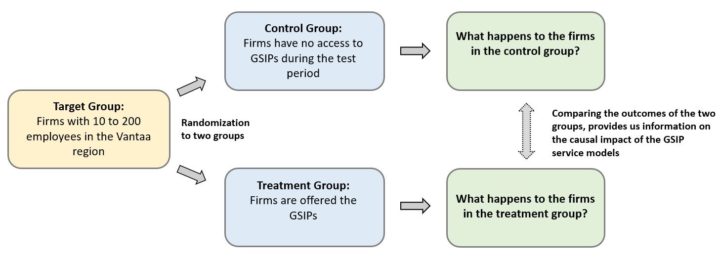Urban growth – GSIP Vantaa committed to finding out what works
TEXT | Hannu Karhunen ja Hanna Virtanen
GSIP-Vantaa is exploiting a research design to test innovative ways to improve the skills and competencies of the local labour force, and to boost employment and growth in the region. In practice, the outcomes of the program participants are compared to those of the firms and individuals randomly assigned to control group. This set up allows us to provide credible information for policy makers and local agents on what works.

Creating and testing innovative solutions
The ability of local economies to meet the challenges created by occupational restructuring and technological development will be critical for their future success. Technological change increases the demand for education and thus, the prospects for the low-skilled workforce are particularly alarming. This development imposes a major threat also for the city of Vantaa which has a very high share of low-skill jobs and citizens when compared to the other large cities in Finland.
The GSIP – Vantaa (acronym for the Growth and Social Investments Pacts for Local Companies in City of Vantaa) project aims to improve the skills and competencies of the local workforce as well as to boost the employment, productivity and growth in the region. The central idea of the project is to create and test innovative service models that provide incentives and tools for firms to participate in the process of enhancing the local labour market.
Learning what works
Despite the massive importance of the topic, we still know very little about the effective ways to update and improve the skills and competences of adult labour force. The GSIP- Vantaa is exploring innovative ways to solve these issues and a crucial component of the project is to increase our understanding of what works. That is, our aim is to show empirically what is the impact of the new GSIP service models on firms and on individuals.
A common challenge always involved in attempts to provide credible information is, how to design the project so that we can learn from it. How to assure that we do not give credit to the GSIP service models for something that is a consequence of the normal regional development? Or how to avoid the possibility that the results are tampered with selection, where only better performing firms and individuals are participating and their superior outcomes are mistakenly considered to be driven by the service models? In this project, we attempt to overcome these challenges by comparing program participants to randomly assigned control group.
How to create a credible research design?
In practice, there were three necessary stages to set up the foundation for the randomized field experiment. Our first step was to create a registry that contains all firms with 10 to 200 employees in the Vantaa region. Next, we divided the firms into six clusters based on their main industry (three clusters) and on the number of their employees (splitting all three clusters in half). Finally, we randomly assigned half of the firms in each cluster in the treatment and control groups. The firms in the treatment group (and their employees) are offered the GSIP service models during the testing period of the project, whereas the firms (and their employees) in the control group are not.
Why to use this procedure? First, the division of the firms into clusters before randomization is to assure that we would have similar firms in both the treatment and control groups. A good balance of the data is especially important in a case like ours where the number of the target firms is very low. Moreover, exploiting randomization is critical to enable a causal analysis. Without a randomization, local agents could select the most potential firms to participate in the program. Or if firms were free to choose themselves, it would be the most thriving firms that would most likely choose to do so. This would make a causal interpretation of the results impossible: we would not learn anything of the effectiveness of the service models by comparing the participants and those not exposed to GSIP service models.
Looking forward together
The GSIP-Vantaa project is under way, and the data to evaluate the effectiveness of the GSIP service models is being gathered. As to be expected, there have been and will be many challenges in incorporating the research design into the project in practice. Without a full commitment of all project partners, a successful implementation of a randomize field experiment would not be possible. However, we are fortunate in that the trust level between project partners is high and any obstacles faced, are tackled together.
The article was originally published in the UIA Project News on February 4, 2020.


